
An ATMS Testbed System Architecture
 |
TRICEPS An ATMS Testbed System Architecture | ||
While only an on-line demonstration of TRICEPS and CARTESIUS can fully display the research and operational capabilities of this ATMIS, an illustrative example is presented via captured screen shots from a live application of TRICEPS using the system's simulation capabilities.
TRICEPS Application Study Area
The sample TRICEPS/CARTESIUS application is a highly congested corridor in the city of Irvine, in Orange County, California. This network (see network schematic below), a sub-network of the full ATMS Testbed network, is a slightly larger version of the network used in the federally-funded Irvine Adaptive Control Field Operation Test. The network includes 4-mile intersecting sections of the Interstate 5 and 405 Freeways, the connecting SR-133 Freeway, and the adjacent sub-network of surface streets. Land use in the area is dominated by the Spectrum, a rapidly growing hi-tech employment and entertainment/retail center. Immediately north and south of the corridor are developed and developing residential areas of Irvine and Lake Forest. The network selected allows for testing the feasibility of diversion strategies that included both freeway-to-arterial and freeway-to-freeway diversion.
The City of Irvine Traffic Management Center (ITRAC) is responsible for traffic operations on the arterial network, with a computer-aided traffic system that controls over 240 signalized intersections, 32 of which are within the test network, and 5 arterial CMS. Signal control is fully actuated, and signal control parameters (minimum and maximum green, phase recall, etc.) are set according to a time-of-day basis. ITRAC also has control over 80 CCTV cameras located at major intersections and connected to the TMC through a fiber-optic network. Caltrans District 12's ATMS uses state-of-the-art computer, software, and communication systems to manage the flow of traffic on the county freeway network. Vital elements at the core of the system's operations include 30 CCTV cameras, 34 CMS, Highway Advisory Radio, 278 metered on-ramps, 1,098 incident call boxes and 258 directional miles of loop detectors. Within the sub-network for which this evaluation was conducted, Caltrans controls 3 CMS, located at the three major freeway entry points to the area. Ramp metering control is performed on all 18 freeway on-ramps within the sub-network.

[ back to top ]
The desire to model wide scale network routing behavior and responses to traveler information lead to the integration of the mesoscopic DYNASMART (DYnamic Network Assignment Simulation Model for Advanced Road Telematics) simulator which provided validated models of routing behavior but lacked the microscopic detail to model all forms of traffic control effectively. A configuration that addressed ATMIS simulation needs directly coupled the PARAMICS (PARAllel MICroscopic Simulation) microscopic simulation model with the mesoscopic DYNASMART model via PARAMICS APIs. The resulting hybrid simulator, deemed PARADYN, is capable of modeling traffic operations and effects virtually any ATMIS technology.
[ back to top ]
CARTESIUS Decision Support System
CARTESIUS is a distributed architecture for real-time area-wide traffic incident response and management that provides cooperation among control modules, or agents, for the development of integrated, network-wide control in response to incidents. The solution process provides interaction mechanisms that enable cooperative reasoning and conflict resolution by combining the desire of each independent system to preserve its autonomy and maintain the control of the facility under its jurisdiction with a willingness of all agents involved to cooperate and unify their problem-solving capabilities to achieve conflict-free, integrated responses. The architecture comprises modules that exchange high-level (i.e., highly processed) information for the identification of traffic congestion and the formulation of appropriate integrated response plans. This information may include partial and potentially incomplete results during the execution of problem-solving tasks and exploits inter-agent constraints to resolve inconsistencies that are due to the limitations of their information, in order to integrate local solutions into global, network-wide control plans.
As currently implemented, there are two agents which are decision-support systems for Traffic Management Center operators. One agent is responsible for the operation of a freeway sub-network and the other is responsible for the network of adjacent surface streets. The modularity of the architecture and the flexibility of the communication protocol provides for the accommodation of additional units, such as decision support for a transit operations agency, for local jurisdictions, or for police or emergency service.

[ back to top ]
Response phases include:
[ back to top ]
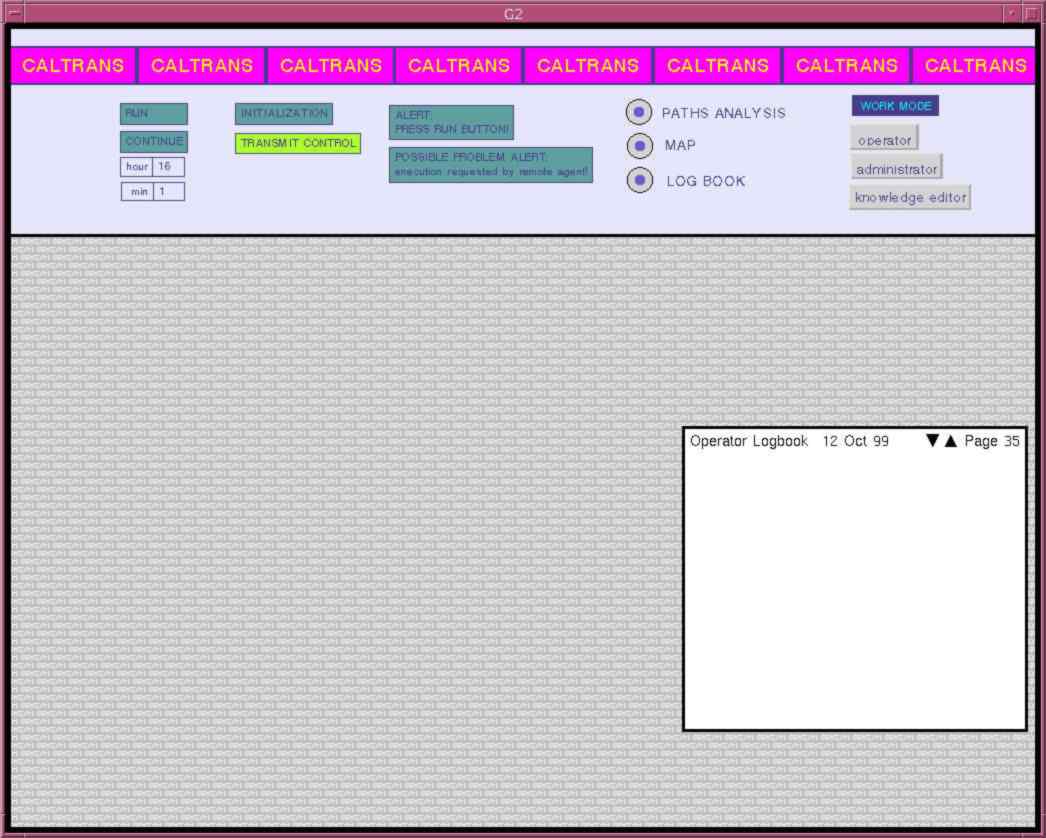
Screen 1
The initial CARTESIUS display for the freeway agent,
Caltrans’ District 12 TMC (note the purple color bar across the
top of the screen; has a yellow bar), shows the various TMC operator
options, including graphic displays of networks and sensor data
streams, as well as communication options with the field and other
options. The initial display for the arterial agent, Irvine’s ITRAC,
is identical except for the yellow agent identifier bar at the top
of the screen (this screen is not shown).
[ back to top ]

Screen 2
In this and the following Cartesius screens, first the freeway
operator (henceforth, D12) is notified of a potential incident on a
freeway link and then conveys this information to the arterial operator
(henceforth ITRAC). The incident detection process may use internal and/or
external algorithms and then notifies the operator for verification.
[ back to top ]

Screen 3
ITRAC: Notice of the freeway incident alert is received by ITRAC
agent who then surveys the ITRAC sub-network for possible problems.
[ back to top ]
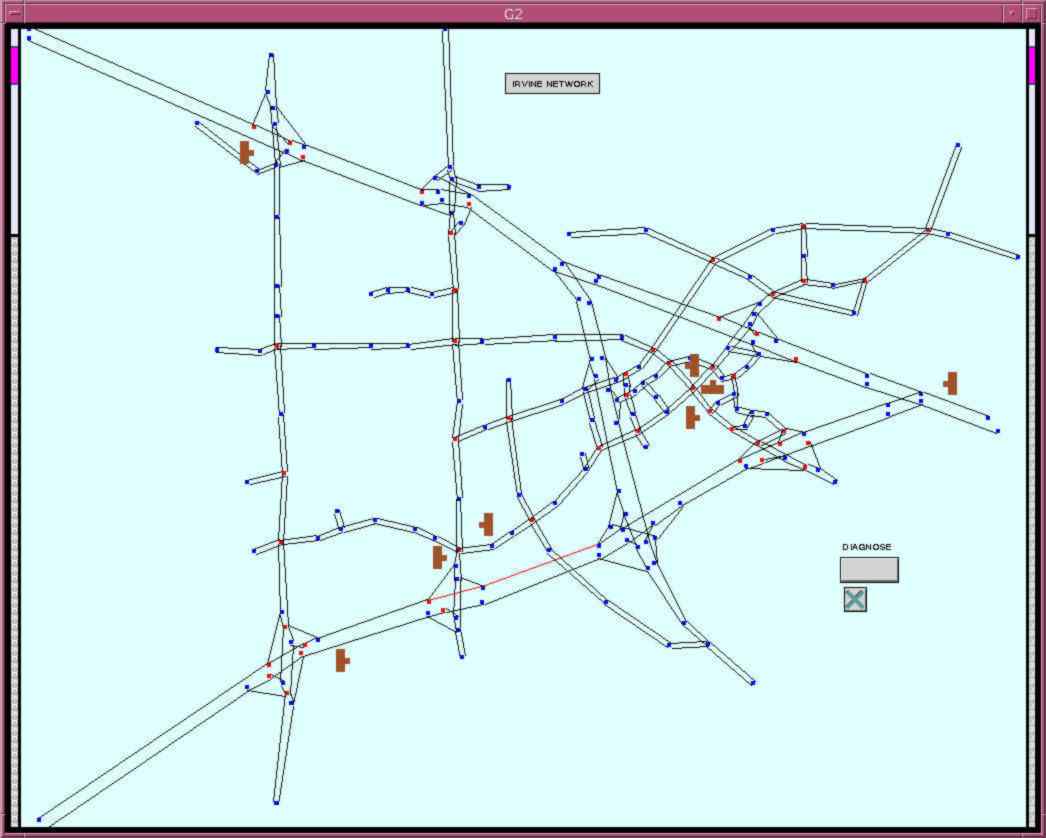
Screen 4
D12: CARTESIUS displays suspected incident link in red
(I-405 northbound between the second and third interchanges from the
left) and requests D12 operator verification (see next screen). At this
point the operator may use a variety of verification techniques, including
direct observation via CCTV cameras or indirect verification via highway
patrol reports, or 9-1-1 calls.
[ back to top ]

Screen 5
D12: Freeway agent diagnosis is completed with operator
confirmation (or rejection) of the now verified incident.
[ back to top ]

Screen 6
ITRAC: The arterial operator, after receiving the freeway incident
advisory, performs an independent system diagnosis on the local sub-network.
[ back to top ]

Screen 7
ITRAC: The CARTESIUS arterial agent detects no local
problems. This information is shared with the D12 freeway agent.
[ back to top ]
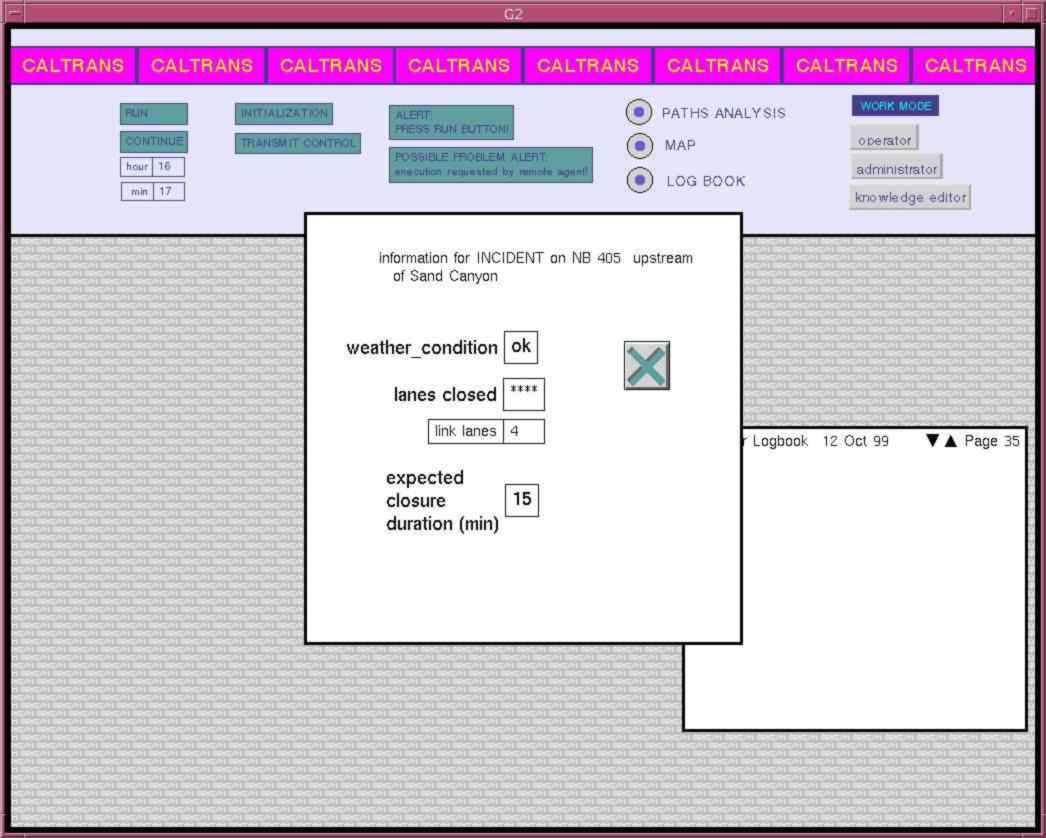
Screen 8
D12: CARTESIUS prompts for basic parameters for the
verified incident.
[ back to top ]

Screen 9
D12: Freeway agent completes initial incident assessment,
including weather conditions, number of lanes affected, and expected
closure duration.
[ back to top ]

Screen 10
D12: The CARTESIUS freeway agent begins analysis of the
congestion problem and the process of generating global solutions for
sharing with other agents (note interaction with the arterial agent
on the message board).
[ back to top ]

Screen 11
ITRAC: Arterial agent solving problem (note interaction with
freeway agent on the message board). Note that only the freeway
agent is formally addressing an identified problem but simultaneous
events, recurrent congestion could place the arterial agent into
active problem solving. At this point, the arterial agent is waiting
for input from the freeway agent.
[ back to top ]

Screen 12
D12: The CARTESIUS freeway agent has generated five
(current maximum) potential solutions, ranked in order of estimated
reduction in global (system-wide) delay. Since this agent has the
only current problem, the operator must select a preferred strategy
to forward to other agents to begin negotiation. Note that each agent
is always free to act unilaterally within their own jurisdictions but
typically the participation of at least one other agent is required to
fully implement the global strategy's management components to achieve
the global solution.
[ back to top ]

Screen 13
D12: The CARTESIUS freeway agent selects Global Strategy 1
to review as a potential preferred response plan to begin negotiations.
[ back to top ]
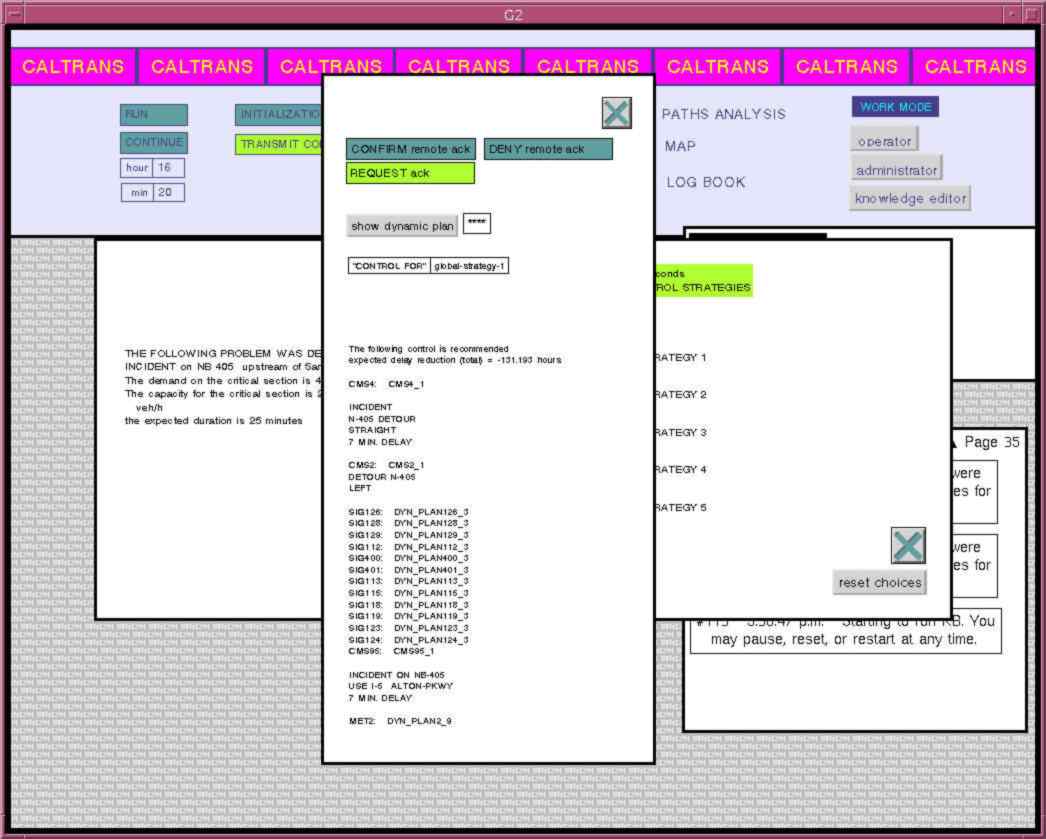
Screen 14
D12: The CARTESIUS freeway operator examines the response
plan for Global Strategy 1 (GS1). This plan includes plan components
for ramp metering rates and CMS on the freeway, and the corresponding
plans for arterial signal control and CMS. The freeway operator selects
this plan as the preferred plan and requests acknowledgement of this
preference from other agents ("REQUEST ack" option is selected),
initiating negotiations.
[ back to top ]

Screen 15
ITRAC: The CARTESIUS arterial agent receives an
acknowledgement request from the D12 freeway agent and examines
the D12-recommended response plan for Global Strategy 1 (GS1).
[ back to top ]

Screen 16
ITRAC: The CARTESIUS arterial agent rejects the request
from the D12 freeway agent for Global Strategy 1 (GS1). A variety of
jurisdiction specific reasons might exist, including expected changes
in background demand during the response period or anticipated impacts
on local streets.
[ back to top ]

Screen 17
ITRAC: The CARTESIUS arterial operator reviews Global
Strategy 2 (GS2) as an alternative response plan and requests
acknowledgement from the freeway agent.
[ back to top ]

Screen 18
D12: The CARTESIUS freeway agent receives the acknowledge
requests from the arterial agent with the Global Strategy 2 preference.
GS2 is reviewed as a potential response plan as negotiations continue.
[ back to top ]
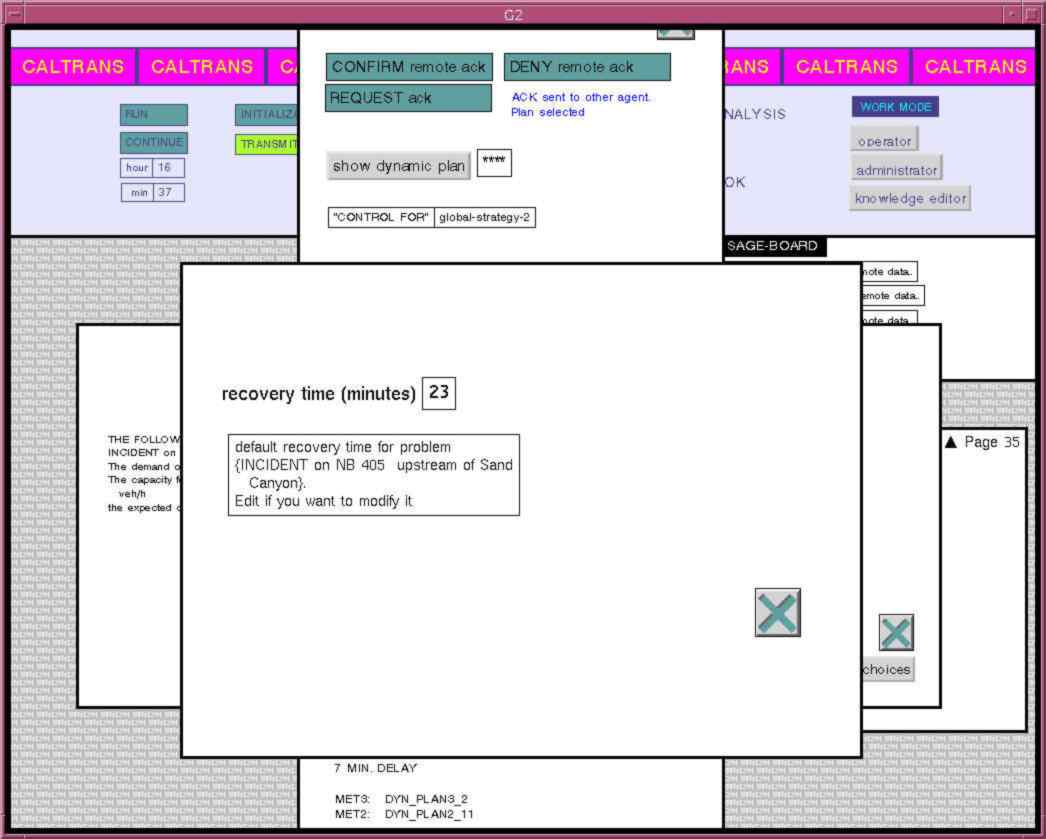
Screen 19
D12: The CARTESIUS freeway agent acknowledges the arterial
agent, accepts Global Strategy 2, and implements GS2 as the response
plan, ending the negotiation. The freeway agent implements freeway plan
components while the arterial operator implements arterial responses.
CARTESIUS can be set to select and implement plans if no response
is received from other agents within some set response time, however,
the actual plan implementation might be limited by jurisdiction policy
regarding unilateral plan implementation.
The freeway agent requests the operator to provide an estimate of recovery time. This estimate will be used as an upper bound when CARTESIUS will again notofy the operator of a (continued) problem situation. It is expected, of course, that all operators will continue to monitor the situation.
[ back to top ]

Screen 20
ITRAC: The CARTESIUS arterial agent reviews and
implements GS2 signal plan changes (here, for the intersection of
Irvine Center Drive and Alton).
[ back to top ]

Screen 21
ITRAC: The CARTESIUS arterial agent reviews and
implements GS2 plan changes for the CMS located on the Alton Pkwy
diversion route. The GS2 plan included this diversion route to
intercept northbound traffic from I-5N (coming from the lower right)
heading for the I-405N, delay their exit until Alton Parkway (the
next I-5N exit). The next two CMS provide arterial directions to
continue on Alton then to detour back to the I-405 at Sand Canyon
Boulevard, immediately north (to the left) of the incident link.
[ back to top ]

Screen 22
D12: The CARTESIUS freeway agent reviews and implements
the GS2 plans for I-405 ramp meters immediately upstream of the
identified incident (here, at Irvine Center Drive). Note the 3 veh/min
rate will severely restrict traffic entering I-405 N upstream from the
incident.
[ back to top ]

Screen 23
D12: The CARTESIUS freeway agent reviews and implements
the GS2 plans for I-405 ramp meters immediately downstream of
the identified incident (here, at Sand Canyon). Note that the meter
has been set to a green ball to allow traffic from the diversion route
to enter I-405 N unimpeded upstream from the incident.
At this point, CARTESIUS has responded by implementing the generated plans in either the real world (real-time mode), the simulated environment (simulated mode), or both (integrated mode). In this example, CARTESIUS continues to monitor the simulation as traffic returns to pre-incident conditions.
[ back to top ]
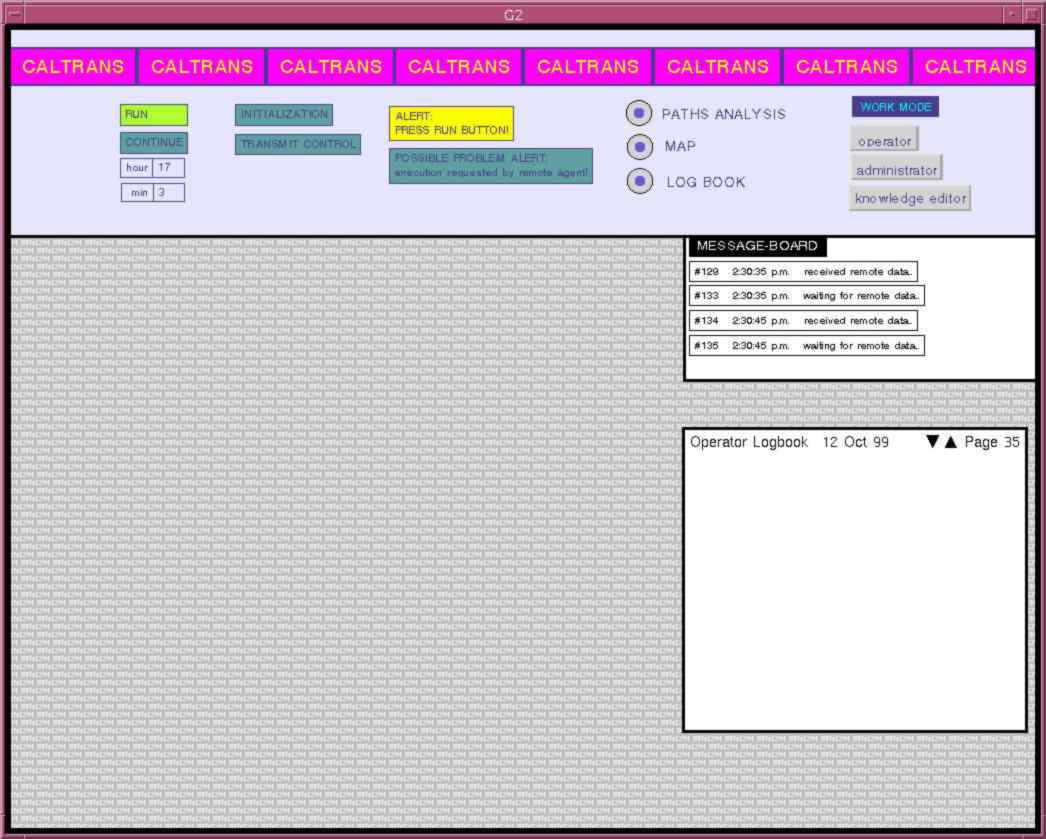
Screen 24
D12: The CARTESIUS freeway agent receives a second alert,
this being generated when the agent "detects" that there is no longer
a problem. This alert will also be generated at the end of the
operator-specified recovery period. Other incidents may occur in the
interim, and these are addressed reflecting current conditions
system-wide (including current response plan conditions).
ITRAC: The arterial agent also receives this alert (screen not shown).
[ back to top ]

Screen 25
ITRAC: The CARTESIUS arterial agent after diagnosing that
no problems remain on the network, thus indicating that GS2 was effective.
D12: The CARTESIUS freeway agent receives a similar system response.
Each agent now has the option to implement the traffic management plans that were in force prior to the incident; the following screens depict some of these actions.
[ back to top ]

Screen 26
D12: The CARTESIUS freeway agent implements the default
time-of-day plan in force prior to the incident. The CMS are reset to
"off".
ITRAC: The Cartesius arterial operator takes similar action.
[ back to top ]

Screen 27
D12: The CARTESIUS freeway agent resets RMS plans
(here, for I-405 at ICD, returning capacity to 10 veh/min).
[ back to top ]

Screen 28
ITRAC: The CARTESIUS arterial agent displays the prior
signal plan being re-implemented at ICD and Alton (this was the
default time-of-day plan).
At this point, the system has returned to the pre-incident management plan and each Cartesius agent continues to monitor the system.
[ back to top ]
At the core of the evaluation process was the assessment of the system's ability to provide traffic control plans in real-time response to the occurrence of incidents. Total and average travel time and traveled distance, were considered suitable MOEs, both because they provide an indication of the network level of service and because they are easily measurable using a simulator.
A set of 18 test scenarios was created, by running simulations of 90-minute peak periods and artificially injecting incidents (temporary reductions in the capacity of a link), by varying such characteristics as the incident location, the associated loss of capacity, and the duration of the capacity reduction. For each scenario, MOEs provided by the simulator (average and total travel time and traveled distance) were collected. For each test case, two simulations were executed: the before case, using the default control (no CMS message and the default, time-of-day signal and ramp meter timing plan), and the after case, implementing the integrated ATMS/ATIS control suggested by the agents in response to the notification of the occurrence of congestion. Both aingle nad multiple incident scenarios were simulated. The comparison of network performance provided a measure of the performance increase that can be expected when the default control is substituted with the ATMIS control plans suggested by CARTESIUS.
For each scenario, average and total vehicular travel time and traveled distance were reported. MOEs suggest that the control plans developed by CARTESIUS, in general, result in a reduction in the average and total network-wide travel time. The average (and total) traveled distance is not significantly affected by the alternative control even though these plans included the use of CMS messages (a result perhaps attributed to the limited size of the network. In some scenarios, the injected capacity reduction was not high enough to cause congestion, thus the agents did not receive any alarm, and no alternative plan was proposed.
[ back to top ]
